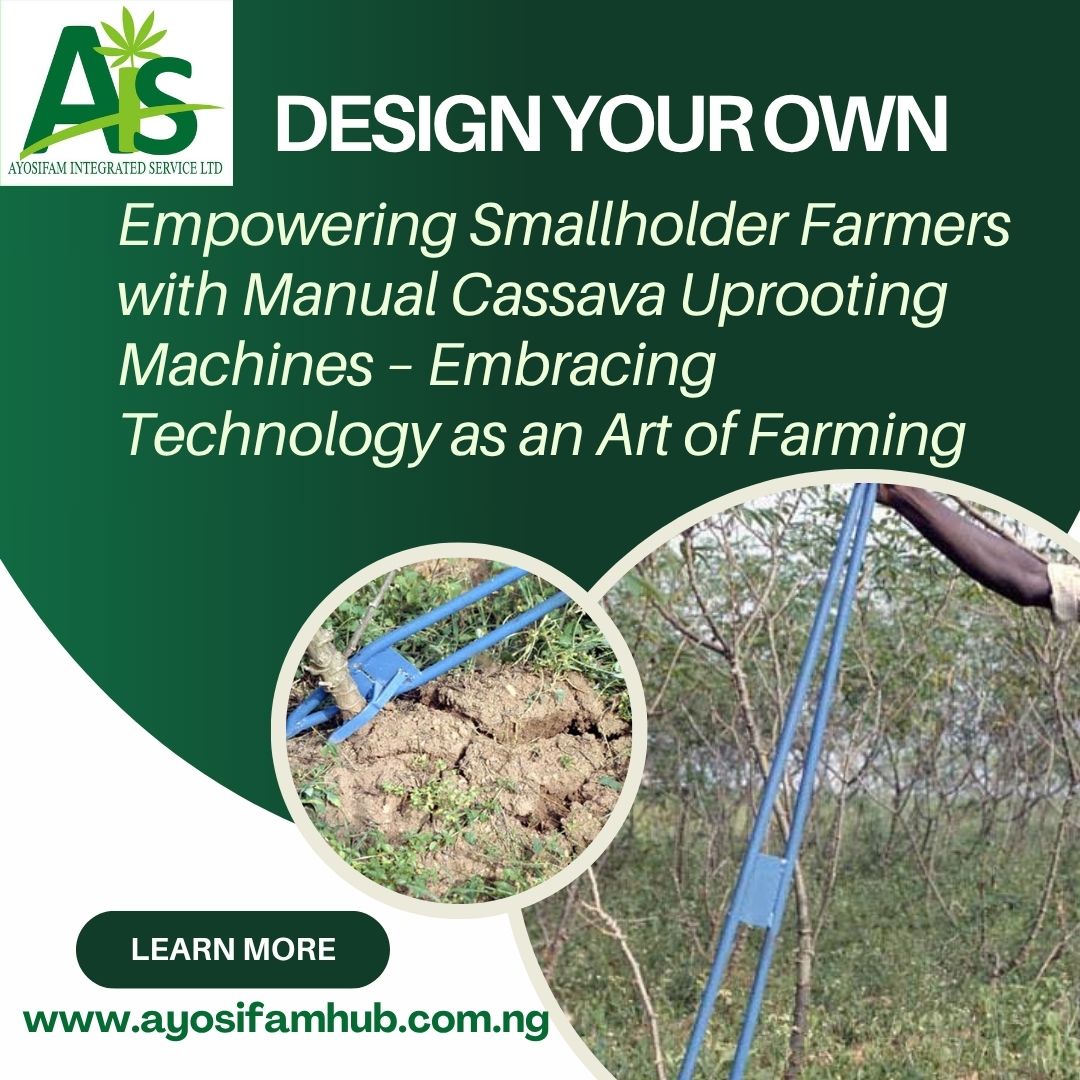Cassava, a resilient and vital staple, forms the backbone of food security and income for countless smallholder farmers across tropical regions. However, the manual harvesting of cassava roots is notoriously labour-intensive, time-consuming, and can lead to drudgery, especially during dry seasons when the soil is hard. For AyosifamHub, we believe in empowering our farmers with practical, sustainable solutions, recognizing that embracing technology is truly an art of modern farming. This article will guide you on how to design a manual cassava uprooting machine that saves time and makes this crucial task easier.
Why a Manual Machine?
While large-scale mechanical harvesters exist, they are often out of reach for resource-poor smallholder farmers due to their cost, complexity, and the need for specialized machinery like tractors. Manual or semi-mechanized solutions, on the other hand, are affordable, require minimal technical expertise, and can be adapted to various farm sizes and soil conditions. This targeted application of simple technology exemplifies the art of smart farming – finding the right tool for the right context.
Where are Manual Machines Making a Difference?
These ingenious devices are already being utilized and further developed in many cassava-producing countries, particularly in Africa and parts of Asia and the Caribbean. Nigeria, being the world’s largest producer of cassava, has seen significant efforts from institutions like the National Centre for Agricultural Mechanisation (NCAM) and various universities to design and commercialize simple, manually operated lifters. Similarly, Ghana has a long history of developing and testing improved manual harvesting tools. Other countries like India (especially in states like Tamil Nadu), Dominica, and Trinidad and Tobago are also exploring and adopting such technologies to ease the burden of cassava harvesting for their smallholder farmers. The principles and designs discussed here can be adapted to suit local conditions in any cassava-growing region, proving that technological innovation isn’t confined to grand, complex machinery but thrives even in the simplest, most impactful designs.
Key Design Principles for Your Manual Cassava Uprooter
When designing your manual cassava uprooting machine, consider these essential principles to ensure effectiveness, durability, and ease of use:
- Leverage is Key: The core idea behind most manual uprooters is to apply the principle of leverage. You want a design that allows a small applied force to generate a much larger lifting force. Think of a simple crowbar – a long handle provides the leverage to lift heavy objects. The machine should use a long handle (lever arm) that pivots close to the ground, with the lifting end positioned to engage the base of the cassava stem or roots. A sturdy metal pipe or solid wooden beam can serve as the handle.
- Strong and Accessible Materials: The machine will undergo significant stress, so material strength is paramount. Focus on readily available and affordable materials. Steel (mild steel is often a good balance of cost and strength) is ideal for the structural components; angle iron or square tubing can be used for the frame. Steel pipes, strong wood, or even reinforced plastic can be used for comfortable grip handles. The ground engagement point (shovel/claw) needs to be very robust and have a sharp or tapered edge to easily penetrate the soil. Hardened steel or thick, treated mild steel is recommended. Some designs might incorporate a “shoe” or “shovel” that slides under the root ball.
- Simple and Robust Mechanism: Avoid overly complex mechanisms. Simplicity makes it easier to build, maintain, and repair. Many successful designs are based on a simple lever: the operator applies downward force on one end of the lever, which translates into upward force on the other end, lifting the cassava. For some designs, incorporating a mechanism that grips the base of the cassava stem can improve efficiency and reduce stem breakage; this could involve hinged jaws that clamp around the stem. A foot pedal incorporated into the design can allow the farmer to use their body weight for additional leverage, reducing strain on the arms.
- Ergonomics and User Comfort: A machine that causes less fatigue will be used more consistently. Design the handle at a comfortable height for upright use, minimizing bending. Ensure handles are easy to hold, perhaps with rubber or tape for better grip and to prevent blisters. Keep the machine as lightweight as possible while maintaining structural integrity for easier portability around the field.
- Minimize Tuber Damage: The goal is to uproot the cassava with minimal breakage, which preserves its market value and usability. Designs that provide a smooth, steady lift rather than a sudden jerk are better for preventing root breakage. Some advanced manual designs might incorporate a small “plough” or a sharpened edge that helps loosen the soil around the tubers before the main lift.
Basic Design Concepts to Explore:
Here are a few common concepts for manual cassava uprooting machines that smallholder farmers can adapt:
- The Simple Lever/Pry Bar Design: This is the most basic. Imagine a strong, sharpened metal bar with a fulcrum point. The sharpened end is driven under the cassava roots. The fulcrum (a stone, a block of wood, or a fixed part of the machine’s frame) is placed near the plant. The operator presses down on the long end of the bar, leveraging the roots out of the ground. Enhancements include attaching a T-handle for better grip and adding a small “foot” or base to the fulcrum point for stability.
- The “Jaws” or “Clamp” Harvester: This design uses two “jaws” that close around the base of the cassava stem. A lever mechanism then lifts the jaws, pulling the plant out. The jaws, often made of strong metal, are positioned at the base of the cut cassava stem. A lever is depressed, causing the jaws to close firmly around the stem and lift the plant. Enhancements include incorporating a small, flat plate at the bottom of the jaws that can slide under the soil to reduce stem breakage and ensure a better grip on the root ball.
- The Foot-Operated Lever Harvester: This design utilizes a foot pedal for leverage, allowing the user to apply more force with less upper body strain. A sturdy frame with a “shoe” or “spade” at the bottom is designed to be pushed into the soil near the cassava base. A long lever arm, connected to the frame, has a foot pedal at its end. When the farmer steps on the pedal, the shoe lifts the cassava. Enhancements include adjustable handle heights to suit different users and adding spikes or serrations to the shoe to help with soil penetration.
Steps to Design and Build Your Own:
- Observe and Understand: Spend time understanding how cassava grows in your soil. What’s the typical root depth? How hard is the soil? What are the common challenges farmers face during harvest? This will inform your design.
- Sketch Your Ideas: Draw multiple sketches of different concepts. Don’t worry about perfection; just get your ideas down. Label parts and consider how they would move.
- Source Materials: Look for scrap metal, old pipes, sturdy wood, or other available materials. Local welders or artisans can be great resources.
- Simple Tools: You’ll likely need basic tools like a hacksaw or grinder for cutting metal, a drill for making holes, and a welding machine (or access to one) for joining metal parts.
- Build a Prototype: Start with a simple prototype. It doesn’t have to be perfect, but it will help you identify flaws and make improvements.
- Test and Refine: The most crucial step! Test your prototype on different cassava plants in varying soil conditions. Pay attention to how much effort is required, if there is significant root breakage, if it is comfortable to use, if there are any weak points in the design, and if it can be easily transported. Get feedback from other farmers; their practical experience is invaluable.
- Iterate: Based on your testing, go back to the drawing board and refine your design. This iterative process is key to developing an effective tool.
Conclusion
Designing a manual cassava uprooting machine is an empowering endeavour for smallholder farmers. By applying basic engineering principles and utilizing locally available materials, you can create a tool that significantly reduces the drudgery of harvest, saves valuable time, and ultimately contributes to greater productivity and prosperity for your farm. This ingenuity and adaptation of tools to meet specific needs is the true art of farming in the 21st century. AyosifamHub encourages you to experiment, innovate, and share your designs with the community, fostering a spirit of self-reliance and progress in agriculture. Happy harvesting!




